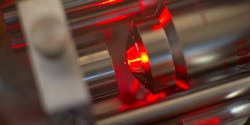Optically levitated nanosphere becomes an ultrasensitive sensor
Optically levitated (via the use of "optical tweezers") nanoparticles can potentially be used for many things; one of them is sensing. Now, researchers at the Photonics Laboratory of ETH Zurich have developed a way to control and eliminate the electrical charge on an optically levitated nanosphere in vacuum, leading the way toward sensing techniques possiblysens including sensitive gravitational-field detection.1
Discharging by high voltage
In a vacuum, the only thing that could disturb measurements is a possible electric charge on the nanoparticle. Owing to such a charge, insufficiently screened electric fields could influence the sphere and, therefore, a possible measurement. For this reason the ETH researchers have now developed a simple but highly efficient method by which the charge on the sphere can be neutralized.
To do this, they mounted a wire inside the vacuum chamber that was connected to a 7000 V high-voltage generator. The high voltage caused the air molecules to be ionized; now, either an electron or ion could jump onto the nanosphere and make its charge more positive or more negative.
To measure the charge carried by the sphere at any given moment, the physicists exposed it to an oscillating electric field and observed how strongly the sphere reacted to that. In this way they were able to confirm that the charge of the sphere changed in steps of exactly one elementary charge to the negative or to the positive. When the high voltage is switched off, the sphere's instantaneous charge remains constant for days.
Gravity and quantum mechanics
This perfect control allows the scientists to completely neutralize the electric charge on the nanoparticle. As a result, electric fields no longer have any effect on the sphere, which makes it possible to precisely measure other very weak forces. One such force is gravity. Martin Frimmer speculates, albeit cautiously, that in future the nanosensor he developed should enable studies of the interplay between gravity and quantum mechanics.
By manipulation of the optical tweezers, the researchers can already cool the sphere down to below a ten thousandth of a degree above absolute zero. At even lower temperatures the nanoparticle is expected to start behaving quantum mechanically, so that phenomena such as quantum superpositions and their dependence on gravity can be observed.
Interesting applications of the sensor also present themselves in everyday contexts, such as the measurement of acceleration. Since the charge of the nanosphere can be not only neutralized, but also set to a well-defined value at will, the sensor is equally suitable for precision measurements of electric fields.
Source: https://www.ethz.ch/en/news-and-events/eth-news/news/2017/06/nanosphere-sensor.html
REFERENCE:
1. Frimmer M. et al., Physical Review A (2017); doi: 10.1103/PhysRevA.95.061801

John Wallace | Senior Technical Editor (1998-2022)
John Wallace was with Laser Focus World for nearly 25 years, retiring in late June 2022. He obtained a bachelor's degree in mechanical engineering and physics at Rutgers University and a master's in optical engineering at the University of Rochester. Before becoming an editor, John worked as an engineer at RCA, Exxon, Eastman Kodak, and GCA Corporation.
